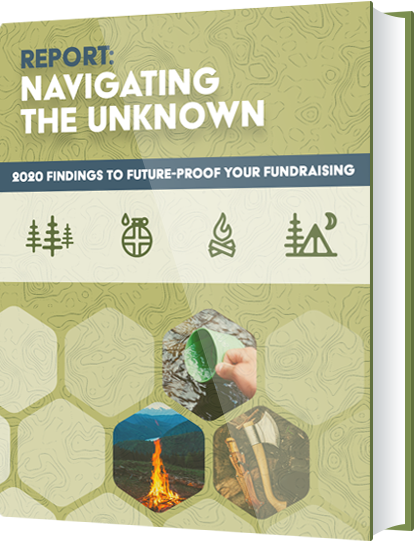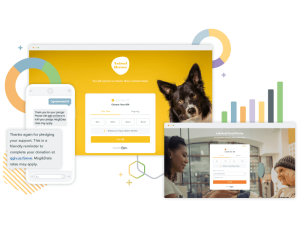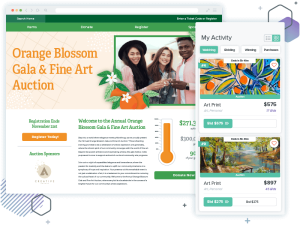We learned a lot in 2020. We learned the significance of community, the importance of cooperation, and how to bake banana bread. If you’re a nonprofit fundraiser, you probably learned a lot about adaptability. When everything shut down in March 2020, we saw nonprofit fundraisers all over the country (and the world!) get creative with their fundraising strategies, campaigns and events.
At the end of the year, the Qgiv team launched surveys that asked nonprofits and donors alike to reflect on the pandemic, other worldwide events, and how those events impacted their relationships with each other. We combed through that data, noticed some interesting patterns, and used those patterns to identify some solid strategies nonprofits can use to improve their fundraising and protect themselves from future disasters.
Here are some of the preliminary findings (and takeaways!) from our fundraising study.
It’s time to start building a crisis communication plan for your nonprofit
During March and April of 2020, we hosted and presented several webinars that included tons of great conversations with fundraisers. One recurring topic during the early months of the pandemic was how to talk to nonprofit donors, clients, and other supporters. Common questions that came up included:
- How do we let our community know what’s happening?
- When should we talk about how we’re reacting to the pandemic?
- How do we communicate closures or program changes?
- Is it appropriate to ask for support right now?
- Should we pause our regular communications? If we do pause them, when do we start up again?
- Our board is worried about communicating or asking for support, but our staff thinks we need to talk to our supporters. What do we do?
All of these questions—and more—are important decisions that should be made before an emergency and included in a crisis communications plan. But most nonprofits didn’t have one in place before the pandemic struck: 65.4% of the nonprofits we surveyed indicated they had no crisis communications plan in 2020.

Now, 64.9% of nonprofits either have a crisis communication plan in place or are actively working on one. If your organization doesn’t have one in place, it’s time to think about creating one! Knowing there’s a plan in place that you can access in case of emergency is reassuring, and it means you won’t have to make important decisions in the midst of a crisis.
Build relationships now so you can rely on them later
The Qgiv team kept a close eye on how donors responded to the COVID-19 outbreak, especially during the spring of 2020 when the pandemic was relatively new. We knew that overall charitable gifts tend to dip during times of economic uncertainty, but we had no idea what to expect. We’d never seen fundraising during a pandemic before!
Donors came through in a big way. But many organizations realized the importance of having strong relationships with their donors. The middle of a crisis is no time to build a relationship (though it can certainly happen), and having close relationships with three groups of donors is an important way to get through a difficult time.
Here are the three groups of donors to focus on:
Existing donors
Attracting new donors in the midst of a crisis is a lot of work. You need to introduce new audiences to your mission, show them the impact they can make by supporting you, and get them comfortable with your organization. Existing donors, though, are already familiar with your work and have proven that they’re willing to support you.
Keeping this group of donors engaged with your nonprofit is the best way to create a sustainable donor base you can rely on during times of trouble. Reiterate this group’s impact on your community, show them how much you value them, and be intentional about your communications with them. When you have to make an appeal in the middle of a crisis, they’ll already know they can depend on you to use their money wisely to support a cause they care about.
Major donors
Major donors were a lifesaver for many nonprofits during 2020. Most nonprofits reported that their major donors gave at or above their 2019 charitable giving levels, even during a pandemic! What a gift!
Major donors, like their counterparts who give at lower levels, need to know that their money makes a real difference for the cause they’ve decided to support. This group has proven beyond a shadow of a doubt that they’re deeply connected to your cause and are willing to invest heavily in the services you provide. If you want them to continue their support during periods of uncertainty or crisis, be very deliberate about building relationships with them. Connect with them on a regular basis, share stories and insights into how they’ve helped, and make sure they’re getting as much out of your relationship as they’re putting in.

Corporate sponsors
The COVID-19 pandemic wreaked havoc on the global economy, so it’s not particularly surprising that many nonprofits reported a dip in support from corporate sponsors in 2020. There are two lessons to be learned here. The first one is that no one organization should depend heavily upon one or two donors or sponsors for a campaign or event. If you want to learn more about this concept, which is called your “dependency quotient,” check out this article over here!
The second lesson is that cultivating relationships with corporate sponsors should be a priority, right up there with cultivating relationships with existing donors and major donors. If you find yourself in a situation where you need extra support from your community, your corporate sponsors should already be familiar with your organization and how working with you can benefit their brand. If your corporate sponsor finds themselves in a tough spot, you want to have a good enough relationship with them that they continue their support anyway.
Of course, there’s no such thing as an absolutely bulletproof corporate sponsorship. But there are steps you can take to make those relationships more stable and more reliable… just in case. Understand what your corporate sponsors want from their relationship with your organization, be intentional about helping them meet their goals (publicity, branding, etc.), and be ready to tailor your relationship to their changing needs if an emergency arises.
Add virtual elements to your fundraising events
As states locked down and everyone adapted to the “new normal” (are you tired of hearing that phrase yet?), many nonprofits moved their fundraising events online. In 2021, we find ourselves in a constantly evolving situation. Some states have opened up and others haven’t. Different states, cities, and even individually owned businesses have different requirements for social distancing, mask-wearing, and venue capacity. The vaccine is being distributed, but nobody has a solid idea of when everyone will be able to get it.
Virtual events are accessible to nearly everyone, which will stay important during our transition back to “normal.” Different people will have different comfort levels when attending in-person events, and many of the nonprofits are using virtual elements to reach as many donors as possible. 23.7% of our nonprofit respondents indicated that they intend to run virtual-only events, and 28.32% plan to run events that combine in-person and virtual elements. Other nonprofits are planning on combining in-person events with virtual events, so everyone in their donor base will feel comfortable supporting them in some way.
Nonprofits embraced virtual events as a way to connect with their donors during the COVID-19 pandemic, but many are discovering unforeseen benefits of this event style. Many reported lower overhead and increased participation, and virtual events’ increased accessibility means they’re reaching new groups and far-flung audiences who can’t otherwise attend in-person gatherings. If you’re looking to lower costs or reach new supporters, consider adding virtual elements to your events. Whether that’s livestreaming video for concerts or entertainment, virtual bidding for silent auctions, remote peer-to-peer events, or something else, embrace technology and add digital engagement opportunities to your events calendar. Your donors will thank you for it!
Conclusion
2020 was a lot of things. It was challenging, it was heartbreaking, it was unnerving. But it was also a learning opportunity, and many nonprofits learned valuable lessons about their processes, their communities, and their supporters. Understanding 2020 and its effect on your nonprofit organization is important, especially as you plan for 2021 and beyond.
These takeaways—that it’s time to create a crisis communication plan, that relationship-building is the best way to mitigate future risk, and that fundraising events need to be at least partially digital to be successful—are only a few of the discoveries and strategies we uncover in our new report. Download “Navigating the Unknown: Findings to Future-Proof Your Fundraising” for more insights, fundraising strategies, and helpful advice from dozens of nonprofits.




